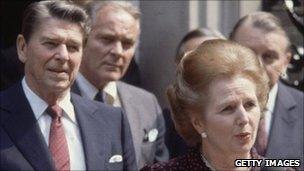Ronald Reagan statue unveiled at US Embassy in London
- Published
Reagan statue unveiled in London
A statue of former US President Ronald Reagan has been unveiled at a ceremony outside the American embassy in central London.
The invited guests include former UK prime minister Baroness Thatcher - who was a close ally of Reagan when they were both in power in the 1980s.
The 10-foot bronze statue was specially commissioned to "recognise Mr Reagan's contribution to ending the Cold War".
A piece of the Berlin Wall will be installed in front of the plinth.
The statue stands outside the US Embassy in Grosvenor Square, opposite the statue of President Dwight Eisenhower.
'True leader'
Lady Thatcher famously described Mr Reagan as "the second most important man" in her life.
She once said he had "a higher claim than any other leader to have won the Cold War for liberty and he did it without a shot being fired".
Rudy Giuliani was asked if on Ronald Reagan's could win his party nomination today
Ahead of the unveiling - which falls on US Independence Day - UK Foreign Secretary William Hague read out a tribute from Lady Thatcher, who was unable to attend because of her frail health.
Lady Thatcher said of him: "Ronald Reagan was a great president and a great man. A true leader for our times. He held clear principles and acted upon them with purpose.
"Through his strength and his conviction he brought millions of people to freedom as the iron curtain came down.
"It was a pleasure to be his colleague and his friend and I hope this statue will be a reminder to future generations of the debt we owe him."
Mr Hague himself described Mr Reagan as "one of America's greatest sons and a giant of 20th Century history".
Mr Reagan famously described the Soviet Union as the "evil empire" and kept up a hardline strategy towards it, escalating the arms race with the USSR during his firm term in office.
However, during his second term, and after encouragement from Lady Thatcher, Mr Reagan employed diplomatic means as well, meeting Soviet leader Mikhail Gorbachev on a number of occasions and putting pressure on him, both publicly and privately, to reform.
Mr Reagan left the White House in January 1989, shortly before the collapse of communism.
Former US Secretary of State Condoleezza Rice also spoke at the unveiling, and said the collapse of the Soviet Union should give encouragement to those seeking greater freedom today in the Middle East and north Africa.
'Underestimated'
"When we think of how impossible that might have seemed it gives us hope and optimism to face other situations that seem today impossible," she told the audience.
"It gives us hope and optimism to continue to stand for those who are still trapped in tyranny.
"It gives us optimism and will to stand with those who profess faith in our values, who have the courage to act on them and whose irrepressible spirit is playing out throughout the Middle East and beyond."

Ronald Reagan and Margaret Thatcher were close allies during the 1980s
Lord Howe, who was foreign secretary under Lady Thatcher, told BBC Radio 4's Today programme that Mr Reagan was "a formidable leader" who did play a crucial part in ending the Cold War.
"Margaret Thatcher saw his potential in that respect as soon as he was elected," he said.
"She said that his election was a watershed in world politics and she saw it as her duty to do all she could to reinforce his bold strategy."
Lord Howe added: "Many people did underestimate him, but he was, in fact, a man of authority, warmth, determination.
"The Reagan doctrine was what he annunciated - that the West would not abandon those countries which had communism forced upon them - so he made a decisive impact on the world in which we live."
Mr Reagan died in 2004, aged 93, after suffering from Alzheimer's disease for many years.
- Published4 July 2011